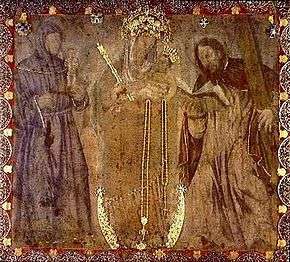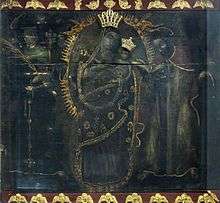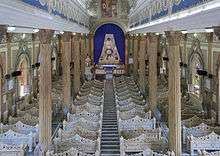Our Lady of the Rosary of Chiquinquirá
Our Lady of the Rosary of Chiquinquirá or the Virgin of Chiquinquirá is a Marian title of the Blessed Virgin Mary associated with a venerated image in the northern Andes region.
Our Lady of the Rosary of Chiquinquirá | |
|---|---|
 | |
| Patroness of Colombia, La Chinita | |
| Venerated in | Catholic Church |
| Major shrine | Basilica of Our Lady of the Rosary of Chiquinquirá, Colombia Basílica of Maracaibo, Venezuela |
| Feast | 9 July, November 18 |
| Attributes | Blessed Virgin Mary standing on a crescent moon, blue cloak, white veil, Infant Jesus, bird, rosary, scepter, St. Anthony of Padua, St. Andrew |
| Patronage | Colombia Maracaibo & Zulia (Venezuela) Caraz, Peru Venezuelan National Guard |
Under this venerated title, the image is the Patroness of Colombia, the Venezuelan state of Zulia, and the town of Caraz in Peru. The image is painted on a cotton support, is kept in the Basílica of Our Lady of the Rosary in Chiquinquirá, Colombia, where religious devotees celebrate her date of Pontifical coronation every July 9.
On 9 January 1910, Pope Pius X authorised the Canonical Coronation of the image, which was not carried out until 9 July 1919 due to the political turmoil prevalent at the time. On 3 July 1986, Pope John Paul II visited the sanctuary and prayed for peace in Colombia at the feet of the Virgin Mary's image. The title given to the Virgin is from the city of Chiquinquirá, where the first of the Virgin's miraculous manifestations occurred, and where the original image from the sixteenth century is kept.
A later image of the Virgin of Chiquinquirá, painted on wood, can be found at the Basílica of Maracaibo, in Maracaibo, Venezuela, where it is also called La Chinita. Every November 18 the city celebrates the traditional Feast of La Chinita with Masses and processions in honor of the Virgin.
Colombia
_-_AHG.jpg)
Pursuant to a commission received from Antonio de Santana, who had received in 1560 an encomienda of the Indians of Suta, a Spanish painter named Alonso de Narváez painted a portrait of the Virgin of the Rosary on a homespun piece of cotton woven by the Indians.[1] Painting in tempera, he used mineral and organic pigments taken from the soil and from herb and flower juices of the region.[2][3]
In 1562 the portrait was placed in a chapel with a roof that leaked, and in time the humidity, air, and sun had so damaged the painting that it was impossible to recognize the subject. In 1577 the damaged painting was moved to Chiquinquirá and left abandoned in a room that had formerly been a family oratory. Eight years later, Maria Ramos, a pious woman from Seville in Spain, cleaned and refurbished the modest chapel and placed in it the faded canvas that had once borne Mary's image. Tradition has it that a miraculous restoration of the painting occurred on Friday, 26 December 1586 which gradually closed the scratches and holes in the cloth, overlaying them with color and light. The image stood out again, having recovered its colors and brightness.[2]
The Virgin of the Rosary in the center of the painting is approximately three feet high. She looks towards her left as if to call attention to the nearly naked Child in her arms. The image has a calm countenance with a delicate smile. Both her face and the Child's are pale. The Child has a little brightly colored bird tied to his thumb and a rosary hangs from his left hand. Our Lady is supported by a crescent moon in a position suggesting the woman of the Apocalypse.[4] A white veil covers her hair and her rose-colored robe is covered by a sky blue cape. With the little finger of her left hand she holds a rosary which hangs in front of her, and in her right hand she has a scepter. On her right stands the figure of St. Anthony of Padua, and on her left that of the Apostle St. Andrew. These were the patron saints respectively of Antonio de Santana, the Spanish colonist who had commissioned the painting, and the Dominican friar, Andres Jadaque, who had arranged for de Narváez to paint it.[2]
The figures appear blurred when looked at closely, but seem clearer when viewed at a distance. The painting has markedly deteriorated through various causes which were assessed by Cecilia Alvarez White in course of a technical examination of the painting in 1986. These include the lack of any prepared ground to size the cotton support, the method of painting, and the nature of the pigments used which tend to degrade through exposure to light and humidity. Alvarez White concluded that the single greatest cause of pictorial degradation occurred over the 50 years preceding her examination, when the painting was exposed to more or less continuous intense electric light.[5] In addition, for three hundred years the image of Our Lady of the Rosary of Chiquinquirá was exposed to the faithful without any protection, permitting thousands to touch the flimsy cloth. Since 1897 a thick glass has protected the painting from inclement weather and from excesses of pilgrim fervor.[1]
Venezuela

The Story of the Prodigy
One day in November, 1709 (or 1749 according to other versions of the story), a woman washing her clothes by the shore of Lake Maracaibo saw a small wooden tablet floating towards her. She picked it up thinking it might be of some use and took it home with her, along with the clothes. The following morning, while preparing coffee, she heard knocks as if somebody was calling her. She went to see what had happened and was astonished to see the tablet shining, with the image of Our Lady of Chiquinquirá now upon it. In a variant of the tradition, the woman first saw no more than the outline of the Virgin on the tablet, and for this reason hung it on a wall of her house; later, on Monday, 18 November, she heard knocking and strange noises coming from inside her house, and upon investigation found the tablet dazzlingly bright, illuminated by lights which shone like a rainbow. Surprised and filled with a strong emotion, she ran out of her house, shouting “Milagro! Milagro!” – hence the name "El Milagro" (which means "miracle" in Spanish) given to the avenue where this woman's house stood. Later on, many people arrived to witness the prodigy.[6]
From that day on, the inhabitants of the state of Zulia in Venezuela, where Maracaibo is situated, found their Queen in what they call the “Chinita”. As it has been expressed by many people, “She is the way that leads to Jesus”. To this day, the tablet, still bearing the image on it, can be seen in the Basilica of Maracaibo.
Legend has it that the government decided that the wood with the image belonged in the capital city, Caracas. So they ordered it moved. As the soldiers following the order carried the image away from Maracaibo it got heavier and heavier until finally no one could lift it. They returned it to the Basilica of Maracaibo where it has remained since.
The Wooden Tablet, the Crown and the Square

The tablet depicting the image of the Virgin Mary was first taken to a small sanctuary built to honor San Juan de Dios and later, under the rule of the governor Francisco de la Roche Ferrer, a bigger chapel was erected to venerate the newly found image of the Virgin of Chiquinquirá. The tablet remained there until the final stage of the Basilica was completed in 1858.
The tablet is relatively small. The dimensions are: 26 centimeters wide by 25 centimeters long and 3 millimeters deep. The Virgin Mary holds the baby Jesus in her left arm. To her left is the Apostle Saint Andrew holding an open book, and to her right Saint Anthony holding a lily (a symbol of chastity) in his right hand. The tablet was restored and preserved, and embellished with 18-carat gold engraving to magnify its beauty.
The crown suspended above the tablet weighs 10 kilograms and it was made of 18-carat gold, donated by the public. Its inner arch measures 27 centimeters by 44 centimeters and a number of precious stones were embedded. It is one of the most highly prized relics in all of Zulia. By the time the crown was made it cost around 250 thousand bolívars.
.jpg)
In the year 2004, the local government inaugurated the “Square of Our Lady of the Rosary of Chiquinquirá”, an open sanctuary reminiscent of the old times. The great monument of the Virgin of Chiquinquirá is located exactly where the washer woman's house once was. The total area of the square is 30 thousand square meters whose epicenter is a 15-meter-high allegorical statue of the Virgin Mary. There are also three mirror-like fountains as well as a smaller square devoted to Saint Sebastian, the patron saint of Maracaibo.
Annual Celebration
The people of Maracaibo celebrate the Chinita's fair in November with an all-night party. One of the main city avenues, Bella Vista, is closed for several blocks and the city puts lights all along the avenue. The lights stay up for months, until after Christmas. There are stages set up, sponsored by the government and businesses around the city. There are firework shows and street vendors, and hundreds of thousands of people line the streets and celebrate all night.
The Chinita's fair officially begins on October 27 when the Virgin is taken down from the altar in which she rests. She tours throughout Zulia State and returns to the Basilica to start all the religious festivities. Around October 2, Bella Vista Avenue sees itself lit up by Christmas decorations, and the local government promotes a series of public concerts with national and international artists to begin the “real” fair. Crowds of people flock together at the different stages or platforms devised to house such concerts.
Other cultural activities are held during the fair. Expo-Zulia is a temporary marketplace where the Zulians show numerous products that characterize the state. Many merchants, stores, companies and artisans offer their products at reasonably low prices. Bullfights are popular, with a number held in the local bullring. The “Toros coleados” finds many “gaiteros” in front of the basilica singing their best gaitas in honor of Our Lady, keeping alive a long-standing tradition of folk music.
The celebrations mark the first salvo of a long Christmas season within Venezuela.
The 17th and 18th of November
The last two days of the Chinita's fair are most special. During these days the great parties around the city are held. By the afternoon of the 17th many people enjoy the multiple concerts and gaita bands that sing in the pubs, clubs and discos. The party begins on the 17th and lasts into the early morning hours of the 18th, with the “Gaitero Daybreak”. Many people go to the Chinita's baseball game right after this traditional party and to the “Toros coleados” in the afternoon.
Pontifical approbations
- Pope Pius VII declared her Patroness of Colombia in 1829, with a proper liturgical feast.[7]
- Pope Pius X granted the image a Canonical coronation on 9 January 1910.
- Pope Benedict XV carried over the decree on 9 July 1919 due to preparations and political climate in the country.
- Pope Pius XI raised her sanctuary to a minor basilica in 1927.[1]
The feast day of Our Lady of the Rosary of Chiquinquira, Patroness of Colombia is July 9, her actual day of coronation.[8]
Veneration
In March 2008, the Colombian daily El Tiempo reported that a crisis that could have ended in an open conflict between Colombia, Ecuador and Venezuela was averted by Colombian President Alvaro Uribe confiding the situation to the intercession of Mary under the three different titles by which she is the countries’ patroness. The crisis started on March 1, when Uribe ordered a military raid into Ecuador's territory, against a rebel camp used by Marxist guerrillas to launch terrorist strikes. In response, Ecuador's President Rafael Correa cut all diplomatic relationships with Colombia. Venezuela's Hugo Chávez, Correa's political ally, ordered a massive military surge to the Colombian border as well. Quoting Fr. Julio Solórzano, Chaplain of Colombia's Presidential Palace, El Tiempo revealed that on March 5, with tensions increasing, President Uribe called for a Rosary to pray for the end of tensions. The Rosary, prayed at the Presidential Palace's chapel, was dedicated, upon Uribe's request, to Our Lady of Chiquinquira, Our Lady of Coromoto, and Our Lady of Mercy, respectively the patronesses of Colombia, Venezuela, and Ecuador. Uribe invited all officials at the Presidential palace to the Rosary, as well as the minister of Defense and the Interior. “For believers – El Tiempo wrote – the prayer was more than effective, since only two days later the presidents of the three countries shook hands, during the Group of Rio summit.” On April 7, at the Dominican Republic summit, the three presidents vented their differences, but agreed to stand down after Colombia apologized for the raid.[9]
See also
- Our Lady of Chiquinquirá Cathedral, Sonsón
- Our Lady of the Rosary
- Mariology (Roman Catholic)
- Roman Catholicism in Venezuela
- Romeria
- Verbena (fair)
- Bullfighting
- Wayuu
References
- ""Our Lady Of The Rosary Of Chiquinquira, Patroness Of Colombia",Family Online, The Society of Mary (Marianists), Vol. 3, No. 19, September 28, 2004". Archived from the original on December 5, 2013. Retrieved March 30, 2013.
- "Latin American Titles of Mary : University of Dayton, Ohio". udayton.edu. Retrieved 2020-05-13.
- Magdalena Vences Vidal, La Virgen de Chiquinquirá, Colombia, 2008, Museo de la Basílica de Guadalupe, coll=Estudios en torno de arte vol. 2, pp.36f.
- "And a great sign appeared in heaven, a woman clothed with the sun, with the moon under her feet, and on her head a crown of twelve stars", Apocalypse, chapter 12:1
- Alvarez White, Cecilia, Chiquinquirá arte y milagro, Bogotá, Presidencia de la Republica/Museo de Arte Sacro, 1986, quoted and summarized in Vences Vidal, Magdalena, La Virgen de Chiquinquirá, Colombia, Museo de la Basílica de Guadalupe, coll=Estudios en torno al arte vol. 2, at pp.63, 147f.
- online article,Virgen de la Chiquinquirá, o Virgen de la Chinita, Patrona del Zulia: Origenes de su Devoción, Tradiciones e Historia, dated 30 September 2009, accessed 29 November 2013
- "ADOM :: Colombians, their virgin and soccer". www.miamiarch.org. Retrieved 2020-05-13.
- ""Marian Feast Days in Latin America", Roman Catholic Diocese of Paterson, New Jersey". Archived from the original on 2013-12-03. Retrieved 2013-03-30.
- "Intercession of Virgin Mary prevented war in South America, newspaper reveals". Catholic News Agency. Retrieved 2020-05-13.